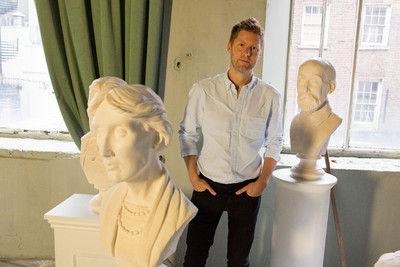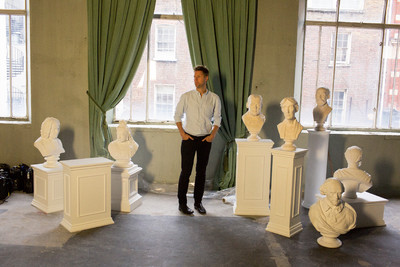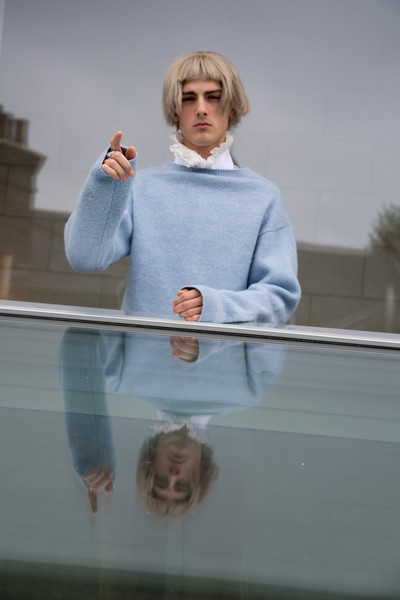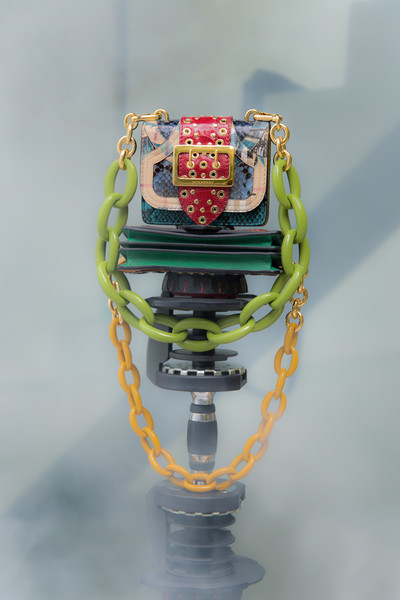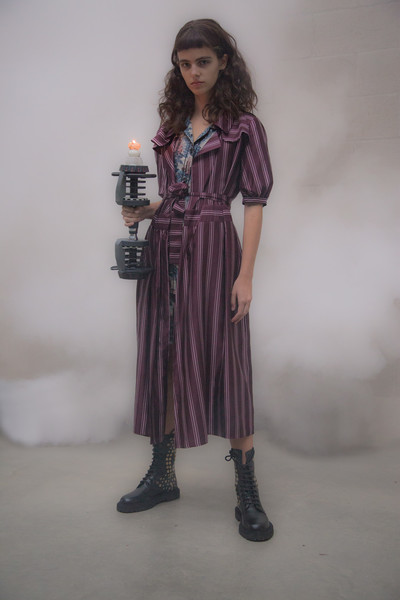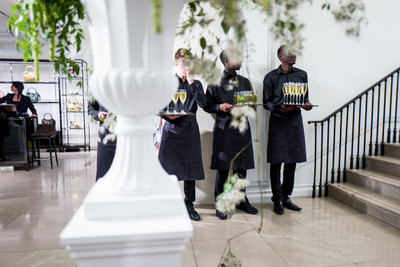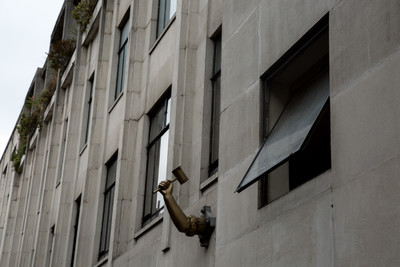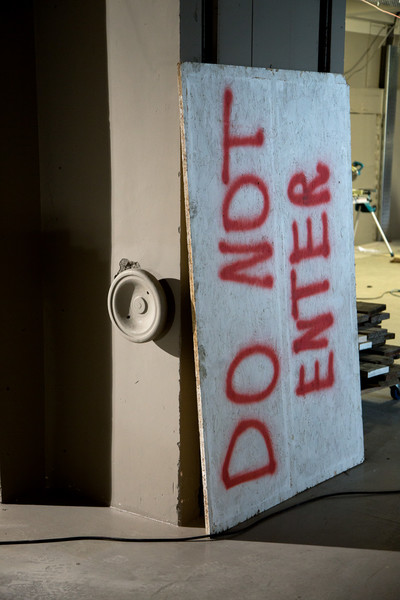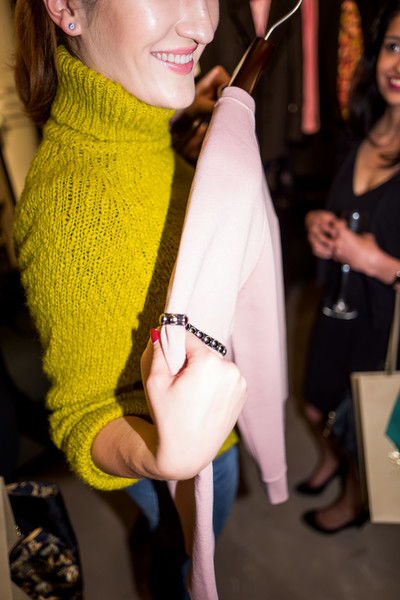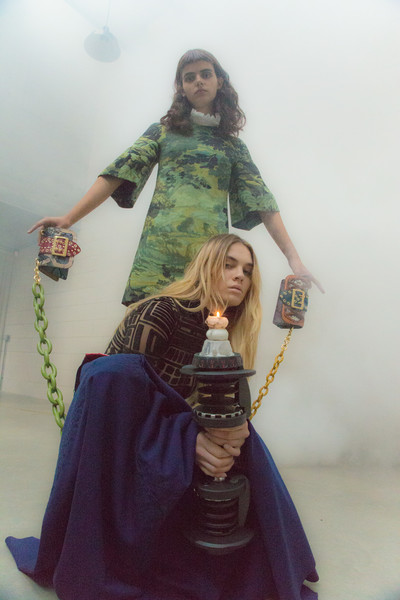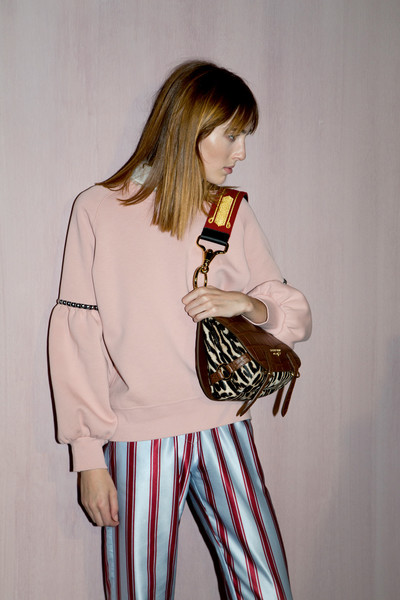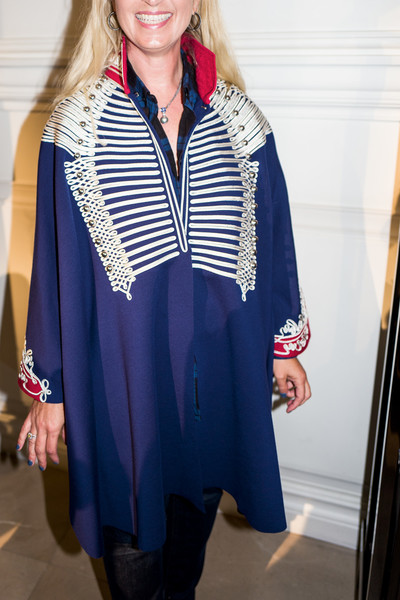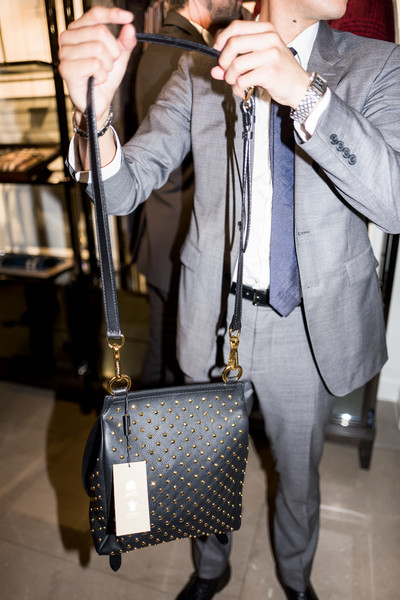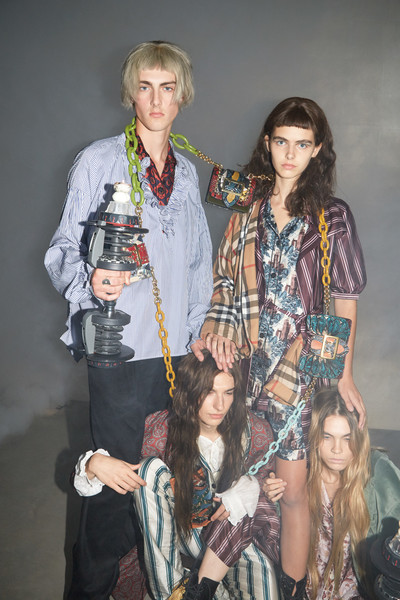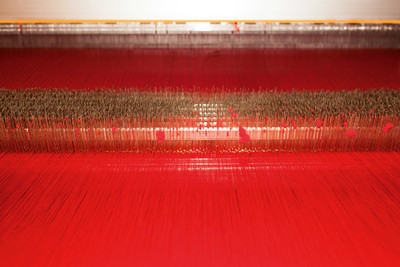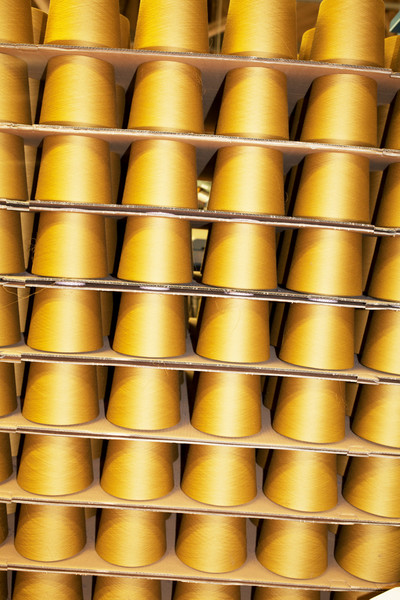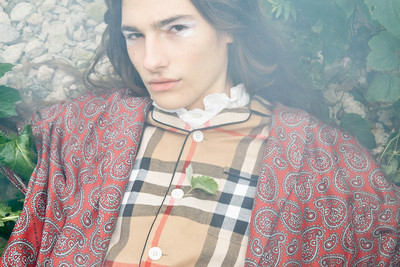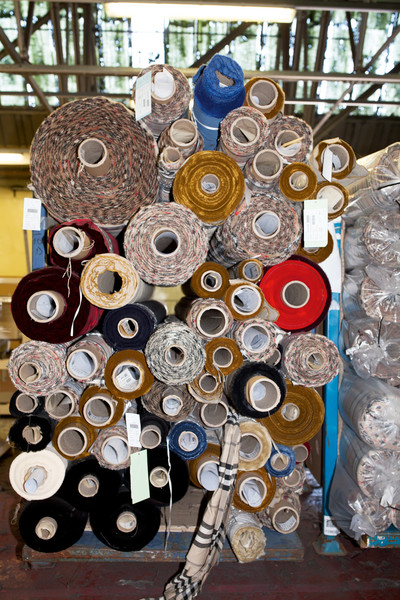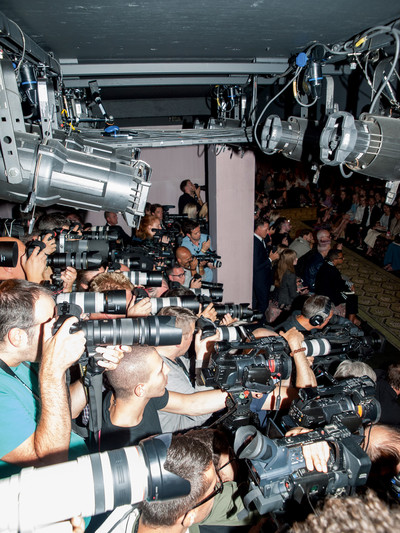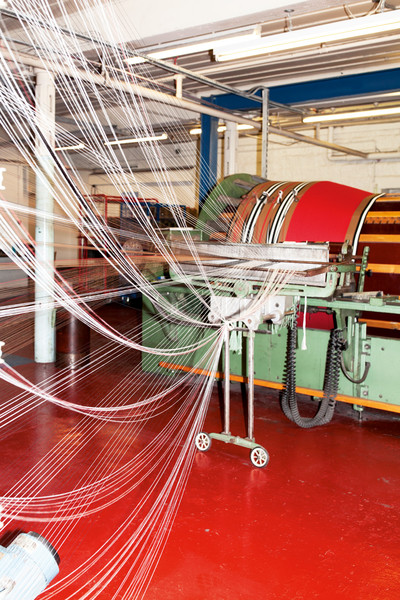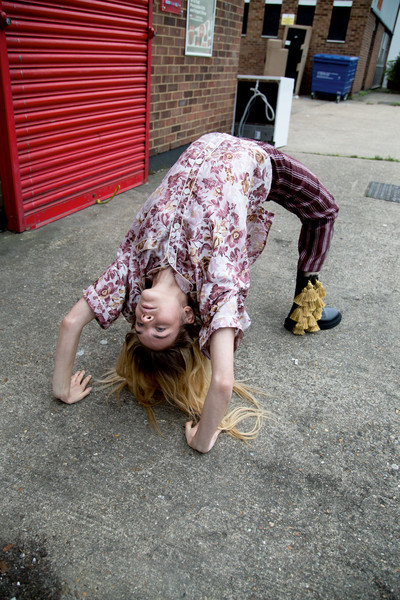By Hannah Rogers.
Photographs by Juergen Teller
Akademie der Bildenden Künste Nürnberg
Burberry’s next-generation move, examined by fashion’s next generation.
Shortly after its hugely polarizing see-now-buy-now announcement was made in February, Burberry gave us a call. Would System be interested in examining the company’s inner workings as it made its idea a reality and launched its first straight-to-store collection?
There was talk of ‘unprecedented access’: CEO and creative director Christopher Bailey could be interviewed on multiple occasions, and we could photograph him, the company’s offices, factories, models, staff, and, most importantly, the crucial show and store debut of the soberly titled ‘September’ collection. After some deliberation (should we commission a high-profile fashion journalist, a novelist or a tech impresario to write the story?), we had an idea. Perhaps the people best suited to chronicling an operational shift being sold as forward thinking were the people who might actually be affected by Burberry’s long-term plans. Fashion’s
next generation.
So we contacted Central Saint Martins to find a promising student fashion writer. Then Juergen Teller suggested that he and 12 of his students from the Akademie der Bildenden Künste in Nuremberg share the photographic assignments.
Burberry gamely agreed to our idea. The following pages present Hannah Rogers’ conversations with Christopher Bailey, and a Teller-curated portfolio of his students’ work. Both are proof of what Christopher told Hannah: ‘It’s always worth trying something different, something new.’
If there is one thing my generation has been taught, it’s that transparency is king. So I’ll come right out with it: when it comes to Burberry, I am a #fangirl. In fact, when the mystery assignment for which System approached Central Saint Martins MA journalism students transpired to be a Burberry story – and that the magazine’s editor had chosen me to write it – I felt like I’d been preparing since I was old enough to covet a trench coat.
Burberry was the first brand I cared about that wasn’t available to buy on a suburban high street. It was the first ‘luxury designer’ store my mother took me into on ask-for-forgiveness-not-permission days off from school. We’d drink the freebie Champagne we were offered, feigning the intention of buying, while I played dress up and fell in love with half the store, not knowing that my mother was making a mental list, ready to secretly purchase one item to wrap and give to me at Christmas or on my birthday. It’s the first brand I watched go through an operational revolution, moving from an over-licensed and underachieving brand to a leader in digital innovation and Brit cool. It captivated me to the point of obsession.
Burberry got me into fashion. So, yes, I’m sentimental. Which means I was less likely than most, in February, to point the finger and charge the company’s announcement of a new runway-to-retail schedule with murder (of luxury, small brands and the relevance of buyers and editors, in one villainous swoop). On top of that, as part of Gen-X-Y-Who-Knows, I think I was supposed to ‘get’ it. I didn’t, though, not fully.
But I’m getting ahead of myself. Firstly, there’s a question that needs asking. Perhaps by everyone. What is luxury? Is it time? Privacy? Convenience? A price tag? An exhausted term used to make us believe something is unique, special, worth buying? According to François-Henri Pinault, CEO of the Kering group, and a fair number of other top industry figures, luxury fashion is a ‘dream’ made real by the time spent waiting for it. Not for me it isn’t. I am an aspirational shopper. I love the buzz of the catwalk show. I love watching them on live-streams, Snapchat stories, Instagram and, on the occasion a CSM student card or mate on the door can blag you a standing spot at the back, in person. But by the time the clothes are usually available to buy, I don’t care anymore. I can’t afford them anyway, and the high-street knock-off is already in my wardrobe. Because of this, the collections don’t necessarily exist in real terms. Which isn’t to say I don’t want them – I really do – but my passion for them comes from big, artistic, blow-your-socks-off statements. It’s about what is Instagrammable, rather than what is wearable. This is the environment in which my interests in fashion and journalism have developed; the tide of change inevitable and stronger than industry institutions.
‘For an industry that talks a lot about moving forward and reflecting the changes in culture and behaviour, I think we can be stuck in our ways.’
Such statements are difficult to achieve in our now-now-now climate. Designers don’t have the time to, ‘cook’, as it were. And with all the musical chairs taking place between the luxury houses, it’s hardly surprising that aesthetic overhaul is rife; Gucci, Balenciaga and Saint Laurent are the proof that stylistic revolution works. Which is what concerned me most about the timing of Burberry’s announcement.
I initially thought Christopher Bailey needed to give himself more creative space and that was why he had decided
to cut his collections down to two a year; why Burberry’s ready-to-wear and diffusion lines were going to be streamlined into one brand; and why seasonal collection titles had been shed and replaced simply by ‘February’ and ‘September’. Burberry designs have been considered ‘safe’ in recent years; you know what to expect. Surely, this was to be a moment to prove critics wrong, to stick it to the nay-sayers. But no indications of that were given. The press statements failed to excite, and suddenly – perhaps inevitably – a lot of voices were suggesting that only a company like Burberry could implement a see-now-buy-now strategy, because only Burberry’s (safe) collections and (sizeable) resources would suit it. I began to wonder whether my history with Burberry had been overshadowing what is hammered into us about objectivity at CSM: you have to look at what is in front of you. Perhaps I had been naive about the business opportunity the strategy presented for the company.
What I’ve found most interesting about the debate around see-now-buy-now – and I accept that I might get slapped down for even suggesting this – is how it has principally been held by a generation whose careers might well be over before the full impact of brand’s new strategy has been felt. Much like Brexit, it feels as though the future is being decided by a group of people who won’t be around to witness it. Equally intriguing amid all the howls of outrage was Burberry’s decision not to fight its corner. Why the silence?
The answer came in June when I was invited to a press and buyers preview of the first see-now-buy-now collection, an affair of secret passageways, non-disclosure agreements and Bond-level secrecy. It turned out that the house’s non-response had a decidedly simple answer: everyone had just been too busy transforming Christopher Bailey’s announcement into a reality to get involved in a shouting match. While there was a sense of trepidation mixed with optimism at the preview, the overall message was also simple: come on, give it a go. My first meeting with Bailey comes a month after this, in late July. As with the collection preview, it takes place at Horseferry House, an impressively immense building situated between Pimlico, Westminster and Lambeth. Burberry HQ has a buzz to it. There’s a lot going on. And at the centre of it is the unassuming Mr. Bailey, awkwardly jumping the 8.59am queue for the lifts, in the company he more or less runs. He’s in good spirits (though that could just be the media training), despite the enormous amount of self-imposed pressure he’s put himself under in the past few months. The dust has settled since the announcement was made, but only a week ago reports of Bailey relinquishing his dual CEO/creative director role at the company to focus on the latter have surfaced. Now, more than ever, is a time to ask questions about what is happening at Burberry, where the company is going and who is leading the charge. Which side of Bailey’s brain is ruling? Left or right? Work or play? Finance or fizz? For the girl who skipped school to try on trench coats, but is now being schooled in some healthy Central Saint Martins scepticism, it is the perfect opportunity.
‘It wasn’t a headline or about trying to create noise. It was actually quite a profound thing to say, ‘We’re inviting a very different audience in.’’
Part One
Thursday July 21, 2016
Burberry HQ, London
Hannah Rogers: You made your big announcement in February and obviously a lot has been going on since then. But firstly, I’m interested in knowing how you define Burberry today?
Christopher Bailey: That is a big first question! I have always talked about Burberry as this amazingly, richly inspired cultural company. That has always been the foundation of everything that we do. Thomas Burberry was our founder, and he was intensely focused on moving forward, and exploring – expeditions, aviation, exploring the world. What I have always tried to do is retain that curiosity and ask, ‘What does being global today actually mean?’ I have always believed in research and development, and in having the freedom to play. That is the root of what design is about. It’s not about formulas. Formulas come out of playing, and that is why we’ve created this diverse group of people with many, many skills and interests.
What would you say are the key elements of luxury at Burberry today?
I think that whatever we do has a strong point of view, a creative process, and is beautifully crafted – as it should be to have a Burberry name behind it. We are trying to look at the way we work rather
than telling customers they have to be forced into our timings. I’m not pretending it’s a doddle and I’m not saying we’ve got all the answers, by the way. It’s just in the DNA here to always try something new. But that doesn’t mean what we try is right for everybody. We’ve never said it’s right for anybody else.
I think it would be good to outline what see-now-buy-now means at Burberry. Is that even an accurate term to use?
I guess if you want to look at it in very black-and-white terms, you do see the collection now and you can buy it now, if you want. It wasn’t really the way that we thought about it. It was more about thinking what the role of the fashion show is today. Designers want to get as many people to see their show as possible, but then they retreat back into the traditional fashion cycle. What always felt slightly odd to me is that you create these extraordinary events – which I think we’ve become a bit blasé and cynical about – and then try to recreate hype six months later, when the collection finally hits the shops. But the show has actually become a customer-facing moment through all these virtual platforms. So why not follow through on making the collection available to the customer? It’s quite rational, really, rather than a new industry philosophy.
If the show is customer facing, where does that leave the press, the buyers – the industry? Many of your attendees will have already seen the collection when it goes to show…
We knew we had to find a way to ensure that the industry was able to work within
our new schedule. We decided we needed to go back a little bit and create a more intimate, private moment that is embargoed until the main launch, the way that shows used to be.
I like the idea that you’re basically rolling out an experiment you’re not entirely sure is going to work.
I am definitely not sure it’s going to work; I’m not even sure how you’d define ‘working’ today. You know, for an industry that talks a lot about moving forward, I think we can be stuck in our ways. I think that we were the first brand to do a live-streamed fashion show, and I knew that when we did it, it was a big shift. It meant the dynamics of what that show was were changing, so I made it that you could buy certain pieces immediately from the runway. It wasn’t a headline or about trying to do something that created noise. But it was actually quite a profound thing to say, ‘We’re inviting a very different audience in’. Having done that, it didn’t make sense to me to show a collection to this new audience, and then expect them to behave exactly like the industry. It felt slightly patronising. That was in 2009, and it started this way of thinking for us. We have just been trying to find ways of bringing people into our world – a peep behind the curtains. And what we are doing this season is just the next step of that. It certainly felt less radical inside the company than the way it was reported externally.
Put like that, it sounds more like a quietly considered evolution rather than a knee-jerk reaction to what you think the consumer wants.
Well, it is! This is evolution, not a headline. I mean, everything is so much more immediate today. I can press a button and speak to someone instantly on the other side of the world. I can have food from my favourite restaurant delivered in a matter of minutes, or I can stay in someone’s beautiful apartment in Iceland. And I feel like fashion has always reflected changing cultures and changes in behaviour.
How has see-now-buy-now affected the structure and the internal workings of Burberry?
Not dramatically. We have to look at our calendar, obviously, and we have to work sooner, but we’re not quite so Spring/Summer and Autumn/Winter. I think it is very difficult in terms of a global company to say, ‘This is my Spring/Summer collection’ – it’s so old fashioned.
‘I don’t believe that people see a show, then tear out an image from a magazine, stick it on the fridge and say, When that comes out, I must go and buy it.’
How is it referred to internally?
By the month that it gets delivered into the store. But then that month here in London might be hot, while the same month in another part of the world might be the opposite. So that is why I talk about these things as being a bit season-less. It’s difficult today to say I’m doing a winter collection, because the collections are so diverse, and represent different parts of the world. Of course, you have to have a point of view to that collection, but it’s not necessarily about just bikinis or just shearling coats.
It is fashion reacting to the world more than the world being forced to react to fashion. It’s fashion with perhaps a little more humility…
That is exactly what it is. I think humility is so important; being open and being receptive and being curious. It’s not sticking with the codes of what the industry says it should be. We all saw what happened to the music business when it tried to hold back the way we all wanted to live. Whether you were a traditional luxury customer or not, you know, those behaviours hit everybody, not just one sector in society.
Do the calendar changes impact your actual design process?
No, because we are always working in advance. You know, it’s not like we’ve done a collection that we’ve designed on Monday and it’s in the shops on Tuesday. That would be physically impossible.
Why do you think your announcement became this big drama in the press? Did you anticipate any of that?
I expected there to be debate, but I definitely underestimated the scale of that debate; people coming out with things like, ‘This is outrageous!’, and so on. I definitely didn’t anticipate that.
It feels like the entire belief system of the industry has been up for debate…
I felt sometimes like it was getting a bit silly, and I came across as old-fashioned and insular. I read comments like, ‘How can you be creative if you are doing something like that?’ Well, that’s not how I define creativity at all.
Why do you think it is that parts of the industry seem to be resisting the digital revolution?
I don’t know. When I joined Burberry, digital was already part of the way that we all lived. It just felt very natural and instinctive. Which is why, for us, the subject of the Internet being bad for a luxury company has always felt alien.
Is Burberry almost at odds now with the industry?
No, I don’t think so. I think lots of people are doing brilliant exciting things; it’s just that we’re doing this. Some people will do versions of this, others won’t.
Do you think your new structure is comparable to the process of high-street fashion?
I haven’t thought of it in those terms. I definitely think it’s about making sure that we are relevant for the way people live, rather than trying to box people into an industry thing – whether that’s the high street or any other sector.
Did you have any hard facts about consumer behaviour that influenced your decisions?
We obviously have a lot of data. As with everything, I always really marry instinct with information. Information tells you about yesterday and instinct tells you about moving forward.
Speaking of the customer, what does this shift in your schedule offer them?
I think it gives a direct window onto the collection that might have historically come in much later and forced them to re-dig. I don’t believe anymore that when people see a fashion show, they print out their little Instagram picture or tear it from an industry magazine and stick it on the fridge and say, ‘When that comes out, I must go and buy it’.
I read once that Marc Jacobs says he gets a real buzz from changing and reworking his collections moments before the show starts. You put this collection to bed three months before your show – I saw it in June. So what would you say are the advantages and disadvantages of wrapping a collection so early?
Well, we still have a deadline, because we were inviting some press in, and you’re a pretty scary lot! I was working right up until that last second before, until the first person walked in, literally.
Nothing really changes for our customer, because I could then argue that pre-show tweaks at another company happen six months before the collection goes to store, and in exactly the same way that it’s happening for us before the press preview.
‘We all saw what happened to the music business when it tried to hold back the way we wanted to live. That hit everybody, not just one sector in society.’
But for you as a designer, are you not missing that instant feedback; the reveal and reaction of the show?
I’ve had lots of reactions and feedback from those press and buyers who have seen it. We’ve moved the calendar back, but there will also be the reaction from the wider audience that sees the show, and then comes to our stores. There will still be that excitement.
I was a big fan of Burberry Brit – that was the diffusion line that myself and my peers were able to buy into – and obviously you’ve chopped Brit and London…
[Laughs] Chopped!
Well, streamlined. But how are you going to assimilate those aspirational customers into the new price points of February and September?
We’re not changing the price points. We’re saying that instead of the collections having a Brit or London or Prorsum label on them, they’ll have a Burberry label, because we found that our customers didn’t really understand the difference.
Younger people are so used to convenience at the touch of a button, is that something that you would agree with?
Yes, although I don’t know if this strategy is aimed principally at the young, but it is, I hope, a relevant approach to today. You grew up in a very different way to me. I class myself as in the middle. I still like my newspaper delivered in the morning because I like the ceremony of reading my paper. But I also have all my news channels on all my digital devices.
Do you remember when you got your first mobile phone?
Yes, and I remember at my first job I had this ridiculous device that did e-mail, but took about an hour to get an e-mail out. I have always loved gadgets. My grandad was an electrician and it was the big thing in our family. Every week he would bring home the latest gadget. I was very close to him, and many, many defunct gadgets were stuffed under his bed; as is the case today, in our house.
Every innovation that Burberry has tested – from live streaming to the way that iPads and technology are used in stores – is about customer service, and that see-now-buy-now again feels like you are principaly serving the customer. Is that something that defines you?
I am very respectful of the customer because, in the end, we are serving people. People enjoy the things that we make. I can see, right now, people talking about our collection on our Instagram feed; the first thing I do in the morning is scroll down the comments. The other day we launched a boot so I am really interested to see what people think: some love it, some hate it, some think it’s too garish.
So the market research is is actually happening right in front of your eyes.
Yes, it’s live. I find that really exciting, and that is why I just question the shows. Because while I am very respectful of our industry, we’re just redefining what the show is, rather than saying or pretending it’s for the industry and buyers. Don’t pretend it’s for the industry and then try and get as many social followers as possible – that’s bonkers!
Although Kanye’s not known for his humility, when I heard about his Madison Square Garden show in front of 20,000 people – of which one person was Anna Wintour, and another was, say, Suzy Menkes, and then there’s basically 19,998 members of the public – it did feel like a very symbolic statement. The industry exists, and it might have a fancy front-row seat, but it only exists within a broader audience.
I could not agree more! But it just kind of shows how much the world is changing, in so many different ways. Something funny happened to me a couple of weeks ago: I was at home and we’d just put our two girls to bed. My partner and I were exhausted, so I rang the Thai restaurant for a delivery. As I went outside, tracking the delivery fella on my phone, I saw a drone flying above our house, probably photographing something. And I was just like, ‘Shit, man, the world has literally changed beyond belief! I can order my food, track its delivery and by the way, there’s a drone in the sky!’
Do you think there will come a point in time when Burberry is as forward thinking in terms of its actual design as much as its creative thinking?
I think we evolve slower in the way that we want to personally express ourselves through clothes. I think it is through the more subliminal or more nuanced things, or the way your clothes might be made – the way that the fibres are created, the sustainability of those fibres, or how deep down the supply chain can I track a particular fibre, yarn or fabric. I definitely think that the technology is in the weaving techniques, the dyeing techniques; it’s in the way that we now use 3D printing to create hardware.
‘I expected there to be debate, but I definitely underestimated the scale of that debate; people coming out with things like, ‘This is outrageous!’’
Is there a big difference between the Burberry trench I’d buy today and the one I’d have bought 15 years ago?
It’s always been gabardine, but the techniques we now use to weave that gabardine are definitely different. So yes, it has changed, but you might not necessarily know it or feel it. And you shouldn’t – you don’t need to know.
To what extent is a member of your Regent Street shop staff aware of the impending changes and the shift in the calendar? Do they even need to be up to scratch with things? At what point are they going to be acclimatizing to the fact that, on September 19, there might be someone banging on the shop door saying, ‘I want to buy the collection I’ve just watched go down a runway on my phone’?
I do something called LiveChat – and I do them regularly – where I talk to the whole company, about 11,000 people. It’s just a webcam essentially and anybody in the company, wherever you work, in a store in Rome or Beijing or in one of our offices around the world, can ask me live questions. So anything we do, I try to kind of say, ‘Hey guys, we’re doing this. I haven’t got all the details yet, but I’ll make sure you guys get them’. So they might not know every detail, but of course they know. And I think that is what attracts a certain person to the company; they are quite excited about those things.
Do you get asked tricky questions?
Yes, sometimes. Really tricky, candid questions, and, you know, you can’t please everyone. I get tons of e-mails from customers too, some of which are people really complaining and others really happy.
That feels very much like a reflection of how polarized digital society is today. You post something on Instagram and seconds later the comments are either ‘Perfection!’ or ‘I fucking despise it!’
Yes, exactly. One of the first things I learned when I joined Burberry, was that everybody had a different opinion of what Burberry should be. I remember it so profoundly. I was berated by different people from the industry telling me that Burberry should be this or that. It was literally black over here and white over there. But then I thought, ‘Just do what you think is right and follow your instinct’. So you can’t listen to every customer voice; you have to go with your instinct.
As your announcement has proven, you can’t please everyone either.
Never, and you shouldn’t try, because as soon as you do you end up becoming bland, because you have no point of view anymore. I often say that our Marmite collections are the best ones.
‘As I went outside, tracking the delivery fella on my phone, I saw a drone flying above. And I was just like, ‘Shit, man, the world’s changed beyond belief!’’
Part Two
Wednesday September 7, 2016
Makers House, London
So it turns out that runway-to-retail fits perfectly into Burberry’s DNA. The show is now consumer facing, translating hype into sales, and it makes sense. This is evolution, not revolution. And in reality, Bailey is less focused on the Facebook crowd than he makes out. Runway-to-retail is not really about attracting the digital generation, being down with the kids or attempting to be some kind of pricey fast-fashion brand. He knows that would never work. Mainly, because we can’t afford it. We aren’t his target customers. Yet. It would be false. Was I arrogant or delusional to assume this was the case? Every other brand out there seems to be trying to get into our pants (or empty pockets) with their marketing. By and large, it doesn’t land. It’s not even on our radar. I’m actually relieved.
So the real question that remains is whether this evolution might have dwindled Christopher Bailey’s capacity for creativity as a designer. Absolutely not, he says. Yet, a partnership with the New Craftsmen – a website selling crafted products made in the UK – has just been announced. This feels like a bit of an obvious, or at least laboured, move, as though a focus on slow processes can distract naysayers from the new retail calendar. It’s all over my Facebook feed though, with friends already making plans to visit Burberry’s ‘all-customers-welcome’ show venue, the Arts-and-Craft-y sounding, Makers House.
Which is where I next meet Christopher Bailey. Wearing a hard hat and a high-vis, he is overseeing the building site that will become the new venue. What was once the original Foyles bookshop, and, funnily enough, a popular haunt of Charing Cross Road-based CSM students, is being Burberry-fied. Walls are being knocked through, staircases assembled, faux-Georgian interior doorways applied, cables hanging, paint samples splattered. It’s hard to believe that in just a few days this space will be hosting 700 of the most influential members of the industry. And being beamed out to the digital world.
We have to shout over drills and dodge construction workers to get the interview done. The only quiet spot is in Mrs. Foyle’s original office, wood panelled, a bit pokey, rather glorious, and now the HQ for Burberry’s project-management team. That’s the thing about evolution. It happens whether we want it to or not. Back in 1929, Foyles was a bastion of British retail, the largest bookshop in the world. Now it’s (temporarily) the home of digitally minded luxury fashion. In just a few months it’ll be knocked into luxury flats. No institution escapes change.
How do you envisage the next few days, in the run-up to the show?
Working with the craftspeople, the music, the physical space, working through how the collections will be presented in our stores all around the world, and what will happen in our windows
as soon as the collection goes in.
Do you feel less in control, like you are not able to make any final tweaks to the collection?
I would argue the opposite; we’ve been able to put a lot more thought into preparations. But also in tandem, we are designing and sketching and draping and playing with the next collection, which is in February.
At this stage in the chronology of events – revealing one collection and preparing the next – what are the unexpected challenges you’ve come across?
There haven’t been any kind of wild surprises. I mean, yesterday I had a thing when I was suddenly like, ‘Did we order all the sizes for the shoes?’ Because normally there are those couple of weeks before the show when we’re like, OK, we need 10 39s, 12 37s. And I was like, ‘Oh God, did we do that?’ But no, to be honest, it’s felt really less dramatic and much more natural, this process.
What are you most excited about?
I’m excited by the whole experience of this building. There will be mistakes and things that go wrong and things that surprise us, or, perhaps, go better than we imagined. I’m also looking forward to seeing how people react to the actual collection. You never really get that moment of excitement when a collection goes into the shops, because it’s impossible – you can’t throw a party for every arrival. People might be like, ‘Yeah, who cares?’ Or they might be excited to be part of something.
Internally at Burberry, is everyone now aware of what is happening next week?
Oh yes! In fact, in two hours I am doing another LiveChat to the whole company. There is always that balance between wanting to share everything and wanting to surprise. They don’t need to know about every aspect. But what is wonderful is just travelling around the world and seeing that the people in our stores are like, ‘The collection is going to be amazing’. There will be a lot in the stockrooms, and it cannot go out before the show, so as soon as the show has happened, it will be on shop floors all over the world. It’s going to be crazy, especially working across all the time differences, but that’s what’s fun about it. Everyone’s like, ‘Who cares what time it is, even if it’s 3a.m.!’
Does this feel like the new ‘normal’?
I quite like that we haven’t got ‘normal’ yet. I feel that we are living through a period of redefining all of our identities and who we are and how we work. The changes that are happening in every industry – as well as culturally, politically and socially – mean that it shouldn’t actually be business as usual. Technology is changing everything, the way we interact with each other, the relationships we are building. I see my nieces and nephews and they have a completely different attitude towards sex and
relationships and meeting people. It’s all very different to the way that was natural for me, but there’s nothing worse than standing still and becoming stagnant.
‘My nieces and my nephews have totally different attitudes towards sex and relationships and meeting people. It’s so different to what was natural for me.’
Tell me about the New Craftsmen.
We worked for the show on a lot of crafts and historical references and ways of working. The New Craftsmen is a wonderful organization in the UK that basically brings together all different crafts from around the country, from weaving and dyeing and embroidery and pottery to sculpture.
And these craftsmen are they actually working on the collection itself?
It’s been completely separate; but that was kind of intentional. We created the mood board and the inspiration and they have taken that to create their own individual worlds. Then alongside all of that, we have a ton of stuff we are doing, using technology – whether it is with social media channels like Snapchat or Facebook – that creates a completely different translation of this speed.
How are you able to assimilate the two?
I find it all blends quite naturally. Burberry is a 160-year-old company, with a young team and young energy. You could say we’re a company of contradictions. But I like that.
Part Three
Tuesday September 22, 2016
Makers House, London
Eighteen minutes. That’s what seven months of build-up, debate and colossal operational shifts accumulated to last night at Makers House. Eighteen minutes, 82 looks, 250 pieces: Burberry’s ‘September’ collection, inspired by Virginia Woolfe’s Orlando and representing the blurring of eras and gender binaries, of what should be taken seriously and what not. Quite relevant, then.
But these were 18 minutes, 82 looks and 250 pieces that many in the room had already seen. Last night, it seems, was less about the clothes, of skirts over trousers, of lace and silk, of boys in effeminate pie-crust collars and girls in chunky tasselled bovver boots. For the press and buyers in attendance, that was the story three months ago, when they were invited to preview the collection. Last night was about revealing the clothes to the world, last night was about fanfare. An orchestra! Hordes of fans behind barricades! Cara Delevingne!
The fanfare was global, too. According to Burberry, 4.4 million people tuned in to the live stream, and it was all systems go operationally: the collection was immediately available online and in stores across 100 countries, despite the fact it had yet to be ‘officially’ judged by the key voices of the industry. Risky.
Or not. Because the judgment was positive. Nearly every report was glowing. And sales were even better; queues outside the Regent Street store preceded any journalists uttering a single good word. Which makes me wonder – what did those reviews count for? By the time they went to press, transactions had already been made. A lot of them, in fact; Burberry insiders reported the collection to be selling ‘like hot cakes’. I doubt anyone will be returning their new hero cavalry jacket (cropped, burgundy, doeskin wool, £3,495), just because a fashion editor didn’t like it.
I’m training to be a critic. My whole job spec, supposedly, is to be an arbiter of taste, to advise, so people trust – or at least care about – my opinion. I should have clout. I should, by proxy, sell clothes. But Burberry seems to have cut out the middleman. It’s created all its own hype. The only judgement that mattered last night, and will continue to matter in the coming weeks and months as the sales figures roll in, is that of the customers. Do they want to buy it? Yes, it seems, they do.
So, I suppose there is one thing I’m wondering about when I sit down again with Christopher Bailey at Makers House, the day after the show: is he now feeling a little bit smug?
Would you say the simple fact that you’ve presented ‘newness’ as a concept has paid off?
As an industry – and I certainly don’t exclude myself from this – we get bored very quickly. I always talk about it in terms of five-to-seven year periods where each five to seven years, you’ve got to reinvent yourself again. It’s changing, getting closer and closer, with less and less time. It’s a real balance, because people want to know what your identity is. I always feel like a brand is like a personality. Imagine if all of us became someone else every two years. There’s a fine line with how much you push that.
At what point in your life were you first made aware that fashion design could – or would need to – incorporate both creative and business thinking?
I feel as if it’s part of who I am. The way that I always describe a designer, similar to what my dad did as a carpenter, is one-half artist – somebody who connects with things on an emotional level,
and who has a clear idea of an aesthetic or communicating an aesthetic – and one-half engineer. An engineer in technical terms – clothes need to fit and work on a body – but also an engineer in the sense of how you construct and organize a company. You have to have those sides if you’re a designer. Not everyone is 50/50. I’m definitely more on the creative side, but the operational side, I love as well.
‘I consider myself somebody who has brain cells, and is also creative. I don’t want to be in this weird bubble of, ‘Oh, we better not scare the designer.’’
To what extent did your experiences working with Tom Ford at Gucci influence the work – and the sheer scale of ambition – you’ve put in at Burberry? And how did that Gucci era shape your personal philosophy towards merging fashion design and business?
I think we’re all influenced by the experiences that we have. Both Donna Karan and Tom were great mentors for me, and are still important people in my life. I was healthily tormented working with both of them, because they’re both incredibly clever, creative people. There’s always a frustration working within that environment, particularly if you have an opinion. But it’s healthy. I was a student in those relationships.
Do you think that made you more capable as both creative director and chief executive? And in light of the recent announcement about your change from CEO to president of Burberry, has that changed?
It hasn’t changed yet. I know the press keep saying it’s changed. Frankly, I wish it had changed! My role now is a mix of billions of different worlds, which I love by the way. Again, contrary to some press reports. I’ve always been a risk-taker, and I like to put my head above the parapet and try things. I’m not afraid of tomatoes being thrown at me, because that’s how you learn, and I don’t have much of an ego. On a personal level, I think it’s OK to try stuff, and if you fail, you fail. I happen to be in a very public role in a very public company, so I guess anything that’s seen as a test that does or doesn’t work can be seen as a failure on a worldwide level. I don’t see that as a failure. When I took that role, it felt right for me and the company. We’re going through huge changes as an organization at the moment to make sure that we’re fit for the future. I think right now, design and creativity is going to be the focus of the future, and I know that’s what I love, so I want to be able to free myself up to focus on that.
Have you ever felt merging creativity and business to be counterproductive?
Never. And I still believe it’s imperative. You cannot live in a bubble. If you embrace social media, for example, you suddenly have a dialogue. It’s a conversation. Historically, as an industry, we’ve had our words, window displays, ad campaigns. It’s not been a two-way conversation. Now it’s a proper conversation. That means you can’t separate business, and fashion and creativity.
You previously worked alongside CEOs Rose Marie Bravo and then Angela Ahrendts, so did you find it lonely at the top when you became CEO yourself, without that business voice to dialogue with?
No, not lonely. I loved working with the team that I hired. With Rose Marie, she had an experience, I had an experience; our partnership was unique. It was the same with Angela; we both had different experiences. With Marco [Gobbetti, Burberry’s recently appointed CEO], it’s going to be nothing like what I had before, because he has a different world of experiences. We’ll dovetail together.
Marco doesn’t come from a particularly digital background, having come from Céline, and previously Bottega Veneta. What are you hoping he’ll bring to Burberry?
A partnership is where each person brings a point of view and a skill. I think the digital and technological side is something I’m incredibly passionate about. It’s not something Marco
has promoted as an idea. He clearly understands the world, but given his existing experience, it’s not something he has ever pushed. Likewise, he has enormous experience that I don’t have in retail and operations, and translating a creative vision into a very slick retail environment. Those are just two little examples, but I hope that we will create a partnership based on both of our strengths and passions.
Is the pressure off a bit, now that you’re no longer CEO and creative director? Do you feel a slight sense of relief?
No, none whatsoever. Number one, Marco’s not here yet. He starts next year. Number two, I’ve always felt fully accountable for this company. It’s not my company, but I’ve always carried that weight of responsibility, and I certainly don’t see that changing with Marco. I’m still out there, putting my views of what this company should be in terms of its creativity, and its fashion. It’s a point of view. And it’s only my point of view. What I mean by that is somebody new coming in as a designer would have a very different way of doing things. When you’re a designer, putting a vision out there, it’s a very bold thing, because you’re telling the world ‘I believe in this’, and that won’t go away.
‘I think the idea that a change in operational functions might affect creativity is fundamentally patronising to a designer and offensive as a concept.’
Fashion is wrapped up in elitism. Yet Burberry’s rapport with the consumer is becoming increasingly democratic. How do you know that approach won’t reduce the emotional interest in the brand for some customers?
First of all, I’m very uncomfortable with the idea of elitism. I’m very uncomfortable with the idea of exclusivity. In the sense that ‘exclusive’ means you are excluding someone, and that’s not what fashion is about, in my opinion. I’m not sure I believe in that; that’s just my personal values. That does not mean that you can’t create something incredibly beautiful. It goes beyond cost for me. It’s why I embrace technology, because I believe in being able to share things. I’m not naive. You can be incredibly inspired by the making of something. It doesn’t necessarily mean you have the means to buy and live with that product.
Why has fashion been associated with elitism for so long?
I don’t know. Honestly. I don’t like any feeling of not feeling good enough, or feeling unworthy of experiencing something. Let me tell you a story. I grew up in a very working-class family in
Yorkshire. My mum saw a watch from a famous luxury brand, and she must’ve made a passing comment to my dad like, ‘That is the most beautiful watch I’ve seen’. Dad decided he wanted to buy it for her – I mean, we just didn’t buy things like that; it wasn’t part of our world at all. But he saved up for months. I was a student down here at the time, just 18, and was sent by my dad to Bond Street with the money he’d saved – I’d cashed the cheque he sent me. It was like a different world, the most exciting thing I’d ever done. But when I went into the shop, it was the most intimidating, ruthless and uncomfortable situation I’ve ever been in. I was belittled, and made to feel so inadequate, even though I was about to spend the stash of money in my pocket. I had to lie to my dad about what happened and tell him the experience was magical, but the memory has stayed with me – shopping is not just about money. It’s about the experience, and I hope that the Burberry experience – even when it’s online – is one where we embrace and welcome people. Because I’m delighted at the idea of our customer being somebody for whom Burberry isn’t the norm, and that this could be a major purchase and a major treat. In short, elitism in stores is something that I feel is very old-fashioned, just as a concept.
I have a question for you that I wrote prior to seeing the show last night. Is it a concern for you that the fast pace of digital could be curbing creativity? More specifically, could there be a danger of Burberry’s operational strategy eclipsing its fashion-design prowess?
I think the idea that a change in operational functions might affect creativity is fundamentally patronising to a designer. The idea that you cannot be creative, because you’re operating in a slightly different world, is so offensive as a concept. I consider myself somebody who has brain cells, and also is creative. I don’t want to be in this weird little bubble of, ‘Oh, we better not scare the designer’.
Come on guys, that’s what design is about, finding solutions. This question could only ever come up in fashion; it wouldn’t happen in any other creative industry. So, the answer to the question, I don’t believe so. Quite strongly.
Structurally, how is Burberry going to adapt to these changes? In terms of working environment, a lot of people hot-desk, freelance, etc. Certainly a lot of us coming out of Saint Martins end up freelancing, because it offers more money and a more fluid working life. But Burberry appears to be this considerable machine. How are you going to adapt to the coming years and changing attitudes towards work?
We hot desk like the best of them. We have freelancers like the best of them. We naturally work like that. That way of working is not alien to us. The scale of the company means we can be perceived as a very well-oiled, big, corporate machine, but we’re more agile than that. We’re constantly addressing this, by the way, and I’m very close to Facebook, and they’re all facing the same issues: what does it mean to have a new type of team? Because these very different young lives, coming out of university now, have very different expectations and needs. Then, that new generation gets older, and their needs change again – suddenly they need to start buying a house, and things become more traditional, just by the nature of life. Everything is kind of in cycles.
When was your most recent live Q&A with the staff, and what was the trickiest question to answer this time?
I did one yesterday. Actually, thinking about the previous question you asked about working culture, I remember was a few years ago I was asked by a member of the team why I was getting rid of private offices for people, and opting for open-plan. The answer was: because I hate hierarchy. The argument that I was getting was very relevant, that maybe with a more traditional group of people, they would feel they had been working throughout their career to get an office. Then once they get an office, they want a bigger one because they’re in the next stage of their careers. Then by the time they’re ‘super heroes’, they want a corner office with a view. That’s almost a part of the package. An expectation. Trying to answer that without offending or belittling people was challenging. Because it’s like saying that everything you’ve grown up thinking is rubbish today. And it’s not. Just as your generation has expectations, the last one had expectations. They’re just different.
‘Going into that luxury watch shop as an 18-year-old, was the most intimidating situation I’ve ever been in. I was belittled, and made to feel inadequate.’
Forget corner offices – most of my friends just want a contract! We actually crave security. Having listened to what you’ve said these past couple of months, I feel that you’ve engaged with the consumer independently of the press and are cutting out the middleman of journalism. As an aspiring journalist, am I becoming obsolete?
Figure it out, Hannah. I mean, honestly, I feel like that’s your job. [Laughs] In fact, you’ve got a dream of a job, because there has never been so much written content about what’s happening in the world, yet we all need a filtered point of view to make sense of it. There is no industry that shouldn’t be feeling challenged. We’re living through the next industrial revolution, and it’s a bloody exciting time to be starting a career, because you’ll be shaping it. You have to put your head above the parapet, and when you do that, you can be shot at, and that’s scary. But go figure it out.
Did you ever think when you arrived at Burberry that you would attain this extraordinary level of personal success?
[Long pause] Without being disingenuously humble, I don’t see my time at Burberry as some great success, because I see what we still have to do. I can see that we as a team have been successful. I can see that I’ve been recognized in different ways as the leader of much of the change. I certainly never wanted to be a ‘personality’, and I felt very uncomfortable with it, particularly in the first couple of years when I just didn’t enjoy it all. In fact, I almost didn’t take the job because I realized the job would entail having to be a spokesperson, and as soon as you are the ambassador, whether you like it or not, people want to know who’s behind the company. And I get it, because I want to know that; I want to know what they stand for and what they do. But I felt very uncomfortable with it, just on a personal level. So, to answer your question, I find the whole notion of ‘success’ a bit strange.
What are the metrics of success for yourself? How do you define success?
My life has always been quite extreme. I’ve had, and have, the most extraordinary joy on a personal level. But also the most extraordinary sadness on a personal level. And my home life, my family life, is my foundation for everything. This is my passion, but if I’m not happy at home, I find this really tough. So, success for me is whether I feel serene as a person. Whether I have the right balance in my life. The success of the business, and its financial success or recognition, is unbelievably rewarding, and makes you feel very proud. But if you don’t have that foundation of serenity at home, for me, it becomes meaningless.
How have difficult times in your personal life affected the creative process for you as a fashion designer? If at all.
Interestingly, at the most difficult period of my life, I did a collection that was the sunniest, whitest collection of my career. It was a David Hockney-inspired collection in 2004. I find that a very difficult one to answer, because I immersed myself in work. But that was a very particular period. I’m not sure I became more or less creative. I certainly wasn’t happy. But I don’t know how it might’ve affected my work. It’s just really important to have that outlet. Also, I think you need to connect to a world outside the industry, and that’s what your friends and family do. They help you connect to something bigger.
‘As long as I am at Burberry, we will be bold and curious, and continue to test and trial and challenge ourselves. If we don’t, we’ll be left behind.’
Do you ever not think about Burberry?
Yes. I’ve got two very young girls, and they’re very good at putting things into perspective, because when I’m with them, it’s all about being with them. Like, this morning, I made sure that I didn’t leave the house until eight o’clock, because I wanted breakfast with my girls, and to do something normal.
So I’m actually not bad at compartmentalizing when I’m with my family and friends. When I’m with them, it’s us, a little gang.
When do you find yourself being the most creative or productive? Miuccia Prada says it’s at six in the morning, when she’s half awake; Raf Simons finds it’s late at night, when he’s trying to go to sleep. Is there a particular moment for you?
I used to always think it was afternoons, but these days it’s just whenever I can be 100-percent focused and free, and when I don’t have hundreds of people needing answers from me. I’m not someone who works particularly well at night, and I’m not good if I’m with my family and friends. It goes back to what we were saying about compartmentalizing. If someone calls and says, ‘Hey, you’ve got to design this collection’, I’d have to leave the family, and go and immerse myself in that task. I’m not one of these people who can be having dinner with everyone, while saying, ‘Ah yes, let’s do red! Blue! Green!’ I’m not that person. I’m not flippant. I’d like to be breezy, but I’m not.
How do you deal with stress and the demands of the job?
Fortunately, I’m not a very stressy person. My personality is quite relaxed, and I think that’s because I’m annoyingly responsible. So it’s kind of, ‘I’ve done my best; I can’t do better.’
Are there times you consider personally taking some time out or moving on to a different challenge elsewhere, or simply bowing out at the top of your game?
Yes. I have in the past. I don’t at the moment, though. I like reinvention, and I feel like we’re at the beginning of a reinvention again, and I obviously feel excited about that. I’m crazy busy the whole time, but when I love what we’re doing, there’s nothing better. It’s a cliché, but really it’s like a drug.
Do you think that will continue?
I honestly, genuinely don’t know. If I felt like I was just ticking along, I couldn’t do it. It goes back to that thing of having to feel 100-percent present.
Besides the digital revolution, the past few years in fashion have been defined by overnight stylistic revolutions – in places such as Saint Laurent, Gucci, Loewe, Céline. Is revolution necessary to stay relevant, and would you envisage such a radical stylistic change at Burberry at some point?
I do think about that. Time will help guide the answer to it. I just don’t know, because you have to ask yourself, ‘What is sustainable, and how quickly does change have to happen?’ Right at the beginning, I was saying every five to seven years for me, but who knows. I know that period is getting shorter.
The three-year itch…
Yes. I just don’t have an answer, but that’s why it’s such an intriguing time.
The way your actions at Burberry have triggered such debate makes this feel like a monumental time for you, for the company, for the industry. With the bit of distance that a day after the show can provide, how do you now feel?
I feel that I had underestimated the debate this would trigger within the industry. That really surprised me. But I feel very proud that, as a team we put our money where our mouth was, and I think we did it to the best of our ability. Whether that was good enough is still to be seen. I feel very proud that we talk about being an agile gang, and I think doing something like this, we proved to ourselves that when we need to be agile, we can be. But now I need some time. I need to get to the end of this week to reflect a little bit on what worked, and what didn’t. And the operational side of things. But also, I need to philosophically question it all.
From a pure communications perspective – perhaps the most cynical perspective one could judge by – this seems like a success.
This is not a vanity project; it is something that I fundamentally believe is right for us. I guess it’s made me feel that there are no rules, and we all have to create our own destiny. It’s important to be bold, and not to be afraid of failure, because failure is quite constipating. It means you don’t push yourself. I feel relieved that even after 15 years, I still feel confident enough to be bold. Because often, with experience, comes an increased sense of fear. You know of all the pitfalls, and you know that as a publicly listed company, there’s a very big responsibility to our shareholders – and I don’t take this stuff lightly. But ultimately, there’s a reason for doing this; this was not just about wanting to create some noise. This was not a PR stunt. This was a very thoughtful decision to try new things. And as long as I am at Burberry we will be bold, and we will continue to be curious. We will continue to research and develop, to test and trial, and to challenge ourselves. If we don’t, we’ll be left behind.
